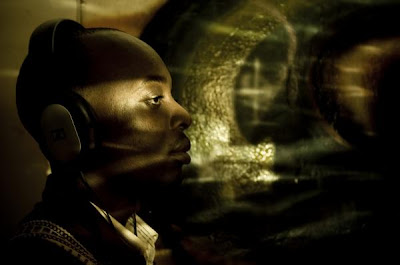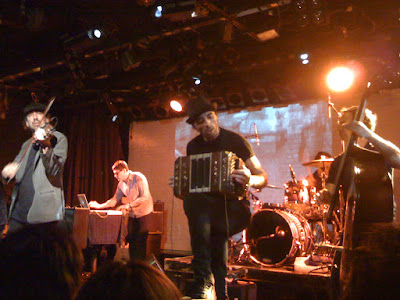 After I first heard about your band and started playing the only song I owned of yours – Midnight - in my car and in parties (and everywhere), people here in the States always said two things: they asked who you were, and they said you sound like the Californian ska band Sublime.
After I first heard about your band and started playing the only song I owned of yours – Midnight - in my car and in parties (and everywhere), people here in the States always said two things: they asked who you were, and they said you sound like the Californian ska band Sublime.But how would you describe your sound?
Experimental Tropical Pop.
How and when did you guys meet?
We've know each other for decades because we hail from a little African village called Maputo. Growing up we were all practically neighbors. We hooked up as a band when we kind of accidentally bumped into each other in Johannesburg, that was sometime in 2ooo, I think.
When did you decide you wanted to create music and stick with it?
When we all felt we were onto something.
If you weren’t a musician, what would you be doing?
Making movies. I'm actually concentrating a bit on that right now.
Being from Maputo, Mozambique, do you think you will ever do a song in Portuguese or feature Lusophone artists?
I'm sure we will, eventually, and we've wanted to but for some reason we always end up cruising out of that.
Who is your favorite Mozambican artist and why?
Fany Mpfumo, because he really was an artist. He represented and still represents Mozambique people better than anyone who tries to.
How has living in South Africa impacted your music?
I think it made us more professional and more aware of what works and what doesn't.
What artists and music styles would you say were your biggest musical influences?
Sublime, definitely. The Police. Nirvana. Gorillaz. And many many more...It's hard to say. I think outsiders can distinguish our influences better than we can.
What is the best part about playing music for a living and having people love what you create?
Having people who actually flock to our shows to sing along to something we crafted from scratch. That still amazes me!
Where do you see the band in 5 years?
I can't even imagine the future in a year’s time, let alone 5 years.
What has been your favorite concert venue?
Oooh, difficult one! The old Bassline in Johannesburg did a lot for us. There are plenty of magical venues around.
Who do you sing for, and which new audiences do you want to reach?
We'll sing for anyone who wants to listen. We don't really have a target market, we're not that sophisticated.
What has been your favorite song so far, the one you most want people to remember you by?
Maybe Radio 75. I like the idea behind the song and the fact that it basically has one note.
Radio 75
Listening to your albums it’s easy to see that dub and reggae are your rhythms of choice…what draws you to these sounds?
It's just a default thing. We all like different stuff, and Dub (mainly) is our common ground. We're all always pushing towards different sides, and generally Dub is the one side we can all sway towards without much of a fight. We also started liking it because hardly anyone in South Africa was doing it when we started exploring it.
What’s the idea behind the music video for your single Midnight?
A guy doing the late night shift guarding a typical corporate building bored out of his mind. He's thinking about stuff and allowing his impatience to grow.
How do feel about the way the internet has been reshaping the music industry?
I think it's great. As someone who makes music it's nice to be closer to the people who listen to your music, and that's the main thing the internet is doing to music right now. I steal a bunch of music and I really don't mind people stealing mine. It's a whole market plugged into your computer or mobile phone.
I’ve read you guys randomly picked the name 340ml after stressing about a name for weeks, all because one of you opened the fridge and happened to look at a can of beer. Does the name still sound good?
It was actually a soft drink can. It doesn't sound great to me, and it never will, but I guess it's good at displaying how random we are as musical group. And I guess it's also kind of catchy.
One of my favorite songs of yours is The Untitled Song; any particular reason you guys were unable to name it?
We were having a hard time coming up with a name that wouldn't sound all conscious or high and mighty. We also didn't wanna spoil the song with a dumb name.
The Untitled Song
Who’s the girl in the song Fairy Tales? Or at least, which type of girl is it inspired by?
No one in particular. I think it's a standard worldwide type of post teenager who desperately wants to be part of something. Just a character in a modern day Fairy Tale.
Fairy Tales
What’s the story behind the album name Sorry for the Delay?
People were annoyed with us because they were tired of our first album and needed something new. When we eventually went into studio we felt the need to apologize. We're not only saying we're sorry that the album is only out now but we're also saying sorry to all the people that endure our favorite sound effect (Delay). Even when we were mixing the album we were super conscious about how much delay we would use. I guess it's a play on words with a double meaning thing going.
What’s your favorite SFTD song to play live?
Australopithecus
Australopithecus
What’s the next project after SFTD?
We're trying to organize a SFTD remix album. We already have plenty of remixes, and we also wanna run some type of competition to have at least two remixes by two new comers.
Do you have plans of touring/selling your music in the US?
Nothing concrete yet. Maybe one day.
When can we expect you in Angola?!
We've almost been there a couple of times. We'll keep on trying.
5 musicians/band you listen to weekly, if not daily:
Daily, that's difficult. I flip things quite often. It would have to be quite Pop and enduring. I'll try:
The Beatles; Animal Collective; Radiohead (yup, I'm one of those); Daft Punk; and Mos Def.
Favorite late night crooners when it’s just you and the missus:
Kings Of Convenience, maybe.
Most played song on your iPod:
In the last couple of months: Difference between by Atlas Sound.
Songs/Artists you are currently ‘obsessed’ with:
Obsessed might be quite a strong word. Right now I'm listening to healthy portions of these albums:
Home is Where the Heart Is, by Hugh Masekela;
All Things Must Pass, by George Harrison;
See Mystery Lights, by YACHT;
Wolfgang Amadeus Phoenix, by Phoenix;
Veckatimest ,by Grizzly Bear
Horehound, by The Dead Weather
Favorite WC2010 venue, and will you be attending/playing live gigs?
The Durban stadium looks like it's going to be something special. We have nothing planned, yet. We might be in Europe during the World Cup.
Costa do Sol or Ferroviário do Maputo?
I've been away for too long to decide.
Random thought of the day:
I read a fair amount of books but I hardly ever buy any. Where do they come from? How do they end up in my hands? I should buy a book today.
-Tiago, 340ml
-Photo by 340ml
340ml






























